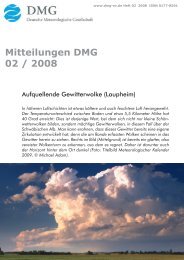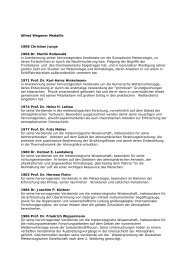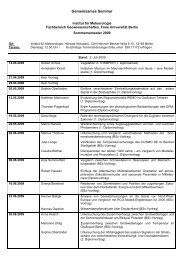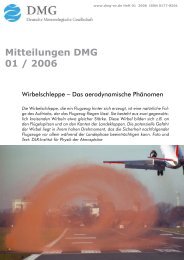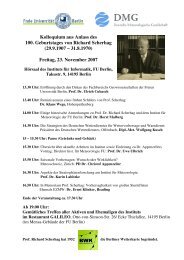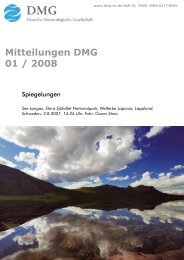Proceedings zur 6. Fachtagung BIOMET - Deutsche ...
Proceedings zur 6. Fachtagung BIOMET - Deutsche ...
Proceedings zur 6. Fachtagung BIOMET - Deutsche ...
Erfolgreiche ePaper selbst erstellen
Machen Sie aus Ihren PDF Publikationen ein blätterbares Flipbook mit unserer einzigartigen Google optimierten e-Paper Software.
measurements. Even if there was only one day experiment in a well defined urban situation<br />
the results are considerable und show the possible use of simple transformations to analyse<br />
thermal comfort for open space design.<br />
4 Use of open spaces with thermal comfort conditions<br />
PET; v; persons<br />
35<br />
30<br />
25<br />
20<br />
15<br />
10<br />
5<br />
0<br />
number PET v<br />
1 2 3 4 5 6 7 8 9 10 11<br />
Period April to June 2005<br />
Fig. 3: Thermal comfort, wind speed and<br />
frequency use of open spaces<br />
Abb.3: Thermischer Komfort und Freiraumnutzung<br />
35<br />
PET oC<br />
40<br />
30<br />
20<br />
10<br />
0<br />
0 20 40 60 80 100<br />
% outside/inside<br />
Fig. 4: Percentage of people inside / outside in<br />
dependence from PET<br />
Abb.4: Prozentualer Anteil der Menschen im<br />
freien in Abhängigkeit von PET<br />
Results from chapter 3 were used to calculate thermal comfort and combine this with observation<br />
how people react on thermal comfort conditions in their open space behaviour. As thermal<br />
index again PET was taken. During 11 weeks alls people were counted using a specific<br />
place just before a bistro. Parallel to that measurements were taken and PET was calculated<br />
from that. In figure 3 the weekly averages of PET, wind speed and the absolute number of<br />
people using that place are shown. First observation which was made is that more people like<br />
sitting outside with increasing PET values. In this example of a moderate but urban climate in<br />
the city of Kassel this is even true if the thermal heat stress occurs with more than 24 o C,<br />
which can be judged as neutral. Especially those people using the place during midday for a<br />
working break seek for warm thermal conditions, especially if they come out of a air conditioned<br />
office. The windy situations during the 5 th week immediately lead to discomfort.<br />
The same result can be derived from another observation concerning the outside or inside use<br />
of the bistro. Figure 4 demonstrates that behaviour, by a comparison between outside or inside<br />
sitting people. Even during the observations of a warm summer day with PET values<br />
above 24 o C not all people look for shadow places inside the bistro, which was much cooler<br />
than, but want to be outside with warm or even heat stress conditions. This behaviour is very<br />
much in accordance to the expectation of the usual warm summer. Disturbing factor for this<br />
knowledge is mainly the activity shortly before, as here a thermal compensation is dominating.<br />
So business jobs in surrounding offices can stand warmer conditions than shopping.<br />
Warm sensation is correlated very much with high solar radiation and low wind speed.<br />
The observations from figure 4 were taken from a bistro, where it was possible to choose between<br />
outside and inside. The bistro was mainly used for short breaks during work or shopping<br />
During the 11 week’s investigation period from April to June the normal behaviour was<br />
an increasing outdoor use with increasing PET. The two exception weeks were combined<br />
with rain and higher wind speeds. One can see that the absolute values of PET often exceed<br />
neutral conditions but still people were looking for sun in the outside. A significant correlation<br />
between PET and outside use of space could not be found.






